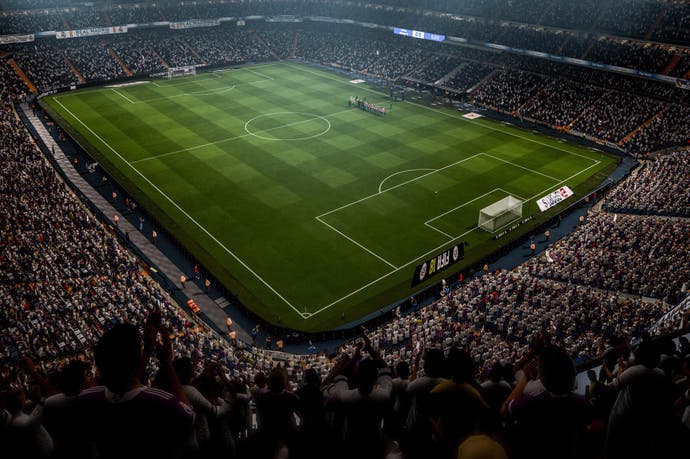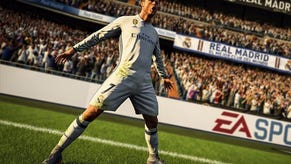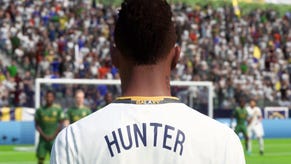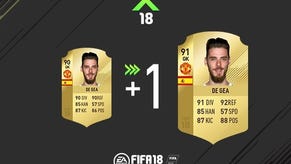Early impressions of FIFA 18
Better graphics, responsive gameplay and The Journey 2.
At a recent event in London, I had the chance to go hands-on with FIFA 18 for a few hours. My early impressions are that it looks better, has some useful gameplay improvements that make a lot of sense, and feels a tad weightier to play.
EA Sports moved FIFA moved over to the Frostbite game engine for FIFA 17, and while it sparked a modest visual upgrade, I didn't feel like it made for a significant leap. FIFA 18 is the game's second effort on the engine, and you can tell. To illustrate the point, EA Sports reps showed Chelsea forward Eden Hazard's face in FIFA 17, and then his face in FIFA 18. It's a marked improvement, with more detail across the board. But I was impressed most by the stadiums, particularly when played during the day. The lighting makes everything look more real, and there's a lot more visual density.
I played a few matches in Boca Juniors' stadium, La Bombonera, and it looks fantastic. You get a great sense of an Argentinian atmosphere, with ticker tape on the pitch, unique flags, banners and even a car on the track that wraps around the field. At the event, creative director Matt Prior said the developers have tried to recreate unique atmospheres at a number of big stadiums in the game - and this extends to how the crowds work.
FIFA's crowds are fine when you're playing a match. It's only when you take a closer look that you see the cracks in the design, such as uniform movement and twinning. The crowds in FIFA 18 certainly look better. When you score a goal and see the crowd react, you'll see more variation in celebration. You'll even see people pile over their seats to try to get to the goalscorer.
Graphics
In FIFA 18, after you score a goal you can run into the crowd to celebrate. I managed to do this a couple of times during my time with the game, sending Chelsea forward Eden Hazard into the arms of his adoring fans. It's a pretty cool thing to do, although I can see it joining the dab as an online troll celebration. Do you get a yellow card for celebrating with the crowd, as you so often do in the English Premier League? EA Sports has yet to work that out, Prior tells me. In real life a yellow card is at the ref's discretion, apparently, and they tend to do things differently from league to league.
The idea that better graphics make for better gameplay seems to course through FIFA 18, and this is where the new Motion Technology system comes in. Now, EA Sports' is partial to giving basic tech upgrades fancy names to make them sound a lot more important than they actually are, but at least in this case the premise makes sense.

FIFA 17 triggers new animations with each step a player takes. This is why players can often look so janky as they're trying to get in position to take a shot, make a tackle or even change direction. FIFA 18, EA Sports says, triggers a new animation with each frame, which makes for a more fluid, responsive and realistic experience. That's the essence of the Motion Technology system.
What this means for how FIFA 18 feels to play is hard to say at this early stage, but shooting certainly feels more responsive. The input lag I perceived with FIFA 17 is gone. At first I thought FIFA 18 played slower than FIFA 17, but I don't think this is the case. It's a weightier experience. The players feel less floaty than they used to, as if there's an increased friction with the pitch. I felt this with the ball, too. It's a little harder to keep the ball under control, and the ball looks like it slows down sooner.
The idea is FIFA 18 feels more fluid to play than previous versions, that the action looks smoother. When you want to dribble, it happens. When you want to move, it happens. Shoot now, not later, that sort of thing. FIFA's always suffered from a sense that there's a buffer between your button press and the on-screen action. I'm not saying FIFA 18 is all of a sudden as responsive as a fighting game, but it's certainly an improvement.
Pace
Where I felt a quite dramatic change is in how pace works. In FIFA 17 the transition between jog and sprint is barely noticeable in terms of the animation of the players, but in FIFA 18 it pops. You can see the player stretch to kick the ball farther - a nice visual feedback that signals you're looking to move into space.
While we're on the subject of running, EA said it's added player archetypes to the game so you should notice different running styles for the 8000 or so players in the game. In FIFA 17, all players shared the same animations for running, which meant a tall player would run in exactly the same way as a small player. In FIFA 18, there are six archetypes, including skinny and stocky. Now, a big player runs differently to a short player.
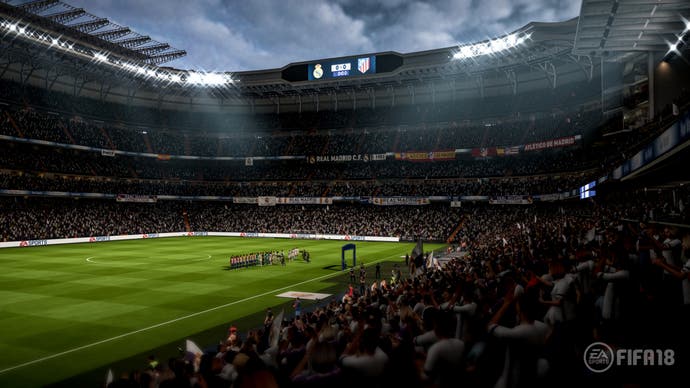
Famous players with unique run styles have been recreated, too. Ronaldo has his distinctive run. Man City forward Raheem Sterling has his palm out chest up running style recreated. Bayern Munich winger Arjen Robben runs in an almost frantic way. Expect all see all three in FIFA 18.
Dribbling
EA Sports has changed the way dribbling works for FIFA 18, based on feedback to FIFA 17. The developers say jog dribble wasn't responsive enough to be of much use in 17, so for 18 the idea is if you're a good dribbler, you can play animations slightly faster than those who are not good at dribbling to avoid tackles. This is the Messi effect recreated - defenders think they can tackle him but fail to because he moves his feet - and the ball - faster than they expect.
The ideal forward, then is a player who can dribble well and then explode into space. So, you'll hold the bumper for close control dribbling, then smash sprint to sprint into space, getting around bemused defenders in a way you can't in FIFA 17. This is what Messi and Ronaldo are so good at in real life - the best footballers the world currently has to offer.
It's worth noting the slow dribble is back (now on the left bumper), and no touch dribble is more effective (it wasn't used much in FIFA 17).
The little things
Some of the little improvements EA Sports has made for FIFA 18 are just brilliant, and make you wonder why it's taken them so long to appear in the game. For the first time you're able to make subs without having to go to team management. When there's a replay, the option to press a trigger button pops up at the bottom of the screen. Hold the trigger and you can press a button to make one of either a custom substitution or a suggested substitution based on who's tired or has a yellow card. And then the substitution happens without a break. Just brilliant!
Crossing has been overhauled. In FIFA 17, crossing was too high and loopy, so much so that the defender and attacker were just waiting for the ball to come their way, and it would be a case of whoever jumps highest gets the ball.

Now, the trajectory of a regular cross is more driven and curled, and subsequently more dangerous. The ground cross is now hold right bumper and press cross. A high cross is hold the left bumper and press cross. (You can still do a ground cross by double-tapping the cross button, if you're really into double-tapping.)
This change makes a lot of sense when you think about how shooting works (left bumper and right bumper change the shot types), and makes you wonder why it's taken so long for EA Sports to bring crossing in-line. But it's here for FIFA 18, and it's welcome.
EA Sports has added a hard tackle (triangle button on PlayStation 4). This is pitched as halfway between a slide tackle and a standing tackle. The player just tries to get the ball, whether there's a leg in the way or not. I found it tricky to use and so reverted to what I know works during my hands-on time, but I can see it ending up useful for some situations.
The penalties have been made more forgiving in FIFA 18. I don't know about you, but I completely failed to wrap my head around the way the new penalty system in FIFA 17 worked. Every penalty I had I pathetically passed to the keeper, rather than smashed into the back of the net. Matt Prior tells me that for FIFA 18 penalties involve, essentially, pointing and shooting, and players should see fewer blasts into row z. Fingers crossed!
The Journey 2
The Journey - FIFA 17's surprisingly okay story mode - returns, this time appropriately called, wait for it, Hunter Returns. It begins with speculation over Hunter's future. Will he stay or will he go? Whatever happens, his story goes wider than the English premier League this time. A teaser image suggests the story takes Hunter to Brazil at some point.
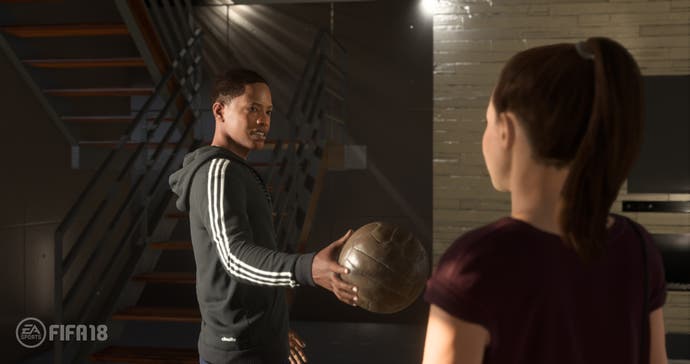
As for how it works, you can customise Alex Hunter with tattoos, outfits and hairstyles. You can carve Hunter into the side of his head, or give him a Paul Pogba haircut, to use two examples. The Journey is now split up into six distinct chapters, each with their own goals so you always have something to aim towards. You interact with more football celebs, including Ronaldo.
Your decisions have a more significant impact on the story and its characters, Matt Prior promised (your decisions didn't amount to much in The Journey in FIFA 17). And now, you can play The Journey in local multiplayer, with one person assuming the role of Hunter, your couch co-op buddy playing as another player on the team.
Early impressions
In recent years, EA Sports has gone for a headline-grabbing new mode for FIFA. Two years ago it was women's international teams. Last year it was a story mode. This year, there doesn't seem to be an obvious big new thing to get the mainstream going.
Instead, EA Sports emphasises gameplay improvements, going as far to compare the gameplay shift between FIFA 17 and FIFA 18 to the jump from HD to Ultra HD resolution. This is, clearly, hyperbole, but for FIFA's army of fans, gameplay improvements will matter more than a story mode they perhaps started but failed to finish.
Is there enough of a gameplay improvement here? This is the big question FIFA 18 has to answer. For now though, I can say this: I very much enjoyed my hands-on time with the game. FIFA 18 feels more responsive, looks fantastic and is packed with nice little quality of life improvements. A promising, if not entirely convincing, start.
